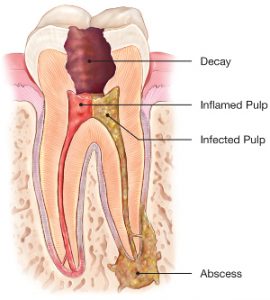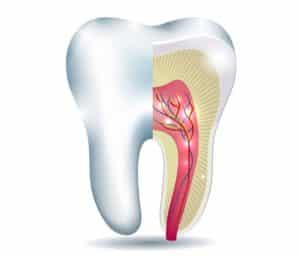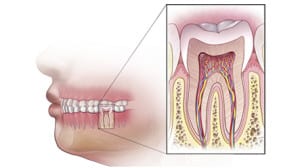What does root canal treatment involve?

Root canal treatment, or root canal therapy (RCT), is required to treat a tooth with a dead, dying or inflamed pulp, more commonly known as the ‘nerve’.
Endodontology, or endodontics, is the art and science of root canal treatment. Endodontics is one of the dental specialities recognised by the Dental Board of Australia, which also maintains the register of specialist endodontists, all of whom have had a minimum of three years post-graduate training.
Endodontic treatment is required when the pulp of a tooth becomes inflamed or if it becomes necrotic, ie; it dies! The presence of a dead nerve can lead to the formation of an abscess. Inflammation of the pulp, or indeed pulp deaths, can be caused by trauma, such as a blow to the mouth or tooth, by deep dental decay (dental caries), the presence of a crack or split in the tooth, or in some cases, simply a reaction to a very deep filling or the placement of a new crown on a compromised tooth.
Endodontic problems can present in an acute phase, with pain and swelling, but in many cases the patient could be symptom free and the presence of an endodontic problem is diagnosed via a routine radiograph, or X-ray.
Endodontic treatment is carried out over one or two visits and involves the endodontist, or general dentist, creating a small hole in the top of the tooth and removing the dead or dying pulp with a series of fine files. Once the canals have been shaped to allow filling, they are soaked with a strong antibacterial solution to make sure all the bacteria are rendered ineffective.
Following this antibacterial irrigation, the root canals are dried with small, sterile paper cones, and then filled with a soft rubbery material.
The final step in the management of the root filled tooth is the placement of a permanent restoration. In some cases, this may be a simple filling, but more commonly a crown or complex restoration is required.
Root canal treatment should be totally pain free, as local anaesthetic is used at all stages.
There is generally minimal post-operative discomfort, which can be controlled with analgesics for a day or two.
When RCT is carried out by an endodontist, the success rate is very high, and the outcome quite predictable.
Who can perform the necessary treatments?

Root canal treatment is sometimes carried out by a general dentist. However, given the high degree of specialisation involved in this kind of procedure, you will often be advised to seek out the services of a specialist endodontist.
In Australia these practitioners have sub-specialised after completing their general dentistry degree, receiving a Master’s or a Doctorate degree in the field of endodontics, during which they undertake original research and build their practical skills in the management of difficult and complex root canal treatments. As previously mentioned, they are required to be registered with the Dental Board of Australia and are strictly regulated.
The cosmetic enhancements that follow endodontic treatment are carried out by your general dentist or specialist prosthodontist – an expert in the restoration of teeth.
How much is treatment likely to cost?
A consultation with an endodontist usually costs about $150 and, although it is preferred, you do not need a referral to be seen.
You can expect to pay anywhere from $1,700 to $2,700 for the actual root canal procedure with the endodontist, and $200 to $450 after the root canal is complete to have the tooth filled.
Is root canal treatment painful?
Back in the old days, having root canal therapy could be quite a traumatic experience, especially before the advent of anaesthetics. As a consequence, root canal treatment has had a bad rap ever since.
However, with technological advancements and new understandings in physiology and pharmacology, this kind of treatment is no longer traumatic. In fact, many root canal patients these days fall asleep during the treatment as there is minimal to no discomfort and they can rest their jaws on a small rubber bite block, so they don’t have to consciously keep their mouth open throughout.
The sensations that most patients feel during today’s root canal treatment, even after the area is numbed, are those of pushing, pulling, pressure and vibration. These sensations are completely normal.
Not normal, however, is any feeling of sharp pain during the procedure. If a patient does feel such pain, they are pre-warned to let their clinician know, as anaesthetic doses and the techniques required to achieve complete numbness vary between individual patients, stages of disease, tooth types and tooth locations. In some cases, adjustments need to be made accordingly throughout the treatment sessions to make you more comfortable.
While modern anaesthetics can control physiological manifestations of pain, they are unable to address psychological manifestations. If a patient is very anxious and tense, effective pain control can be difficult and may need to be managed via additional means. Any affected patient should tell their clinician during the initial consultation, so that extra precautions can be discussed and arranged before treatment begins.
What can you do to make me more comfortable during my root canal therapy?
Your endodontist will usually start by addressing the psychological aspect of any discomfort you might experience. They will tell you what they are going to do and how you can expect to feel, so that you are mentally prepared for it. They will also assure you that you can stop the treatment at any time for any reason.
Generally, 80 to 90 per cent of patients need only this psychological reassurance. If, however, it proves to be inadequate, your endodontist will offer you anti-anxiety medication, to be taken before your appointment. If this is still inadequate, happy gas (nitrous oxide) can be used on top of a conventional anaesthetic to achieve a more pleasant and calming experience during treatment.
As you can see, there are several approaches clinicians can take to ensure your comfort during root canal therapy. The management technique that will be suitable for you will depend on the level of anxiety you experience, as well as on many other factors, all of which are usually gauged and discussed during your consultation.
Please do not hesitate to let your clinician know about any concerns you have. That way, they will be able to ensure that your endodontic experience is as comfortable as possible.
What are the advantages of root canal therapy vs tooth extraction and implant?
Comparing root canal therapy with tooth extraction and implant is like comparing a real limb with an artificial limb.
Unfortunately, the misconceptions tend to drown out the facts when it comes to weighing up the relative merits of these treatments. I would like to clarify some of these misconceptions to give you a clearer understanding.
Myth No. 1: “I would rather get an implant now as I will eventually have to get one anyway.”
Both root canal therapy and a dental implant could have the same success rate. This means ideally, they both would last 15 to 20 years, if not more. If a root canal–treated tooth fails, then one can always have an implant. However, if an implant fails, then each new implant that is placed has a lower success rate. Nothing is forever. In theory, by keeping your own natural teeth longer (with root canal treatment), you are buying yourself time before needing to opt for an implant. This means that the tooth in question can be managed and maintained for longer.
Myth No. 2: “The success rate for dental implants is the same as for root canal–treated teeth.”
Yes, maybe.
If all studies are critically analysed, then one can see a pattern. When it comes to root canal treatment, there is a clear distinction between success (no disease) and failure (evidence of disease). With dental implants, “success” (retention of implant with no disease) is often confused with “retention” (meaning the implant may still be in the mouth despite having disease, which does not equate to success). Often this simple truth is skewed to make implants seem more appealing. Hence what you read on the internet can be misleading.
Implant success can also be dependent on a lot of host factors – such as the site of the implant, quality of bone, immune system, condition of the gums, smoking history and medications being used. Root canal treatment is a lot more forgiving and it has very few factors working against it.
The age of implant placement is also critical. Often the human body can continue to grow until the age of 25 (if not more!). An implant placed in a growing individual may have a compromised cosmetic appearance later in life if continued eruption or jaw growth occurs.
Finally, it can be more challenging to make a dental implant look as “natural” as a real tooth.
Myth No. 3: “Implant technology is new, so it must be a better treatment.”
Not necessarily. New is not always better. Because root canal treatment has been practised since the eighteenth century, it is one of the most exhaustively researched treatments in dentistry. Implant technology has been around only since the late twentieth century and we clinicians are still refining this technology as longer-term data becomes available.
Myth No. 4: “The cost of an implant would be the same as root canal therapy.”
No. The cost of root canal treatment is often half that of a tooth extraction combined with an implant. However, it can come close to par if a posterior tooth is being treated as such teeth often require crowns for structural protection.
Myth No. 5: “I spent a lot of time and money getting a root canal treatment and it failed anyway.”
Just because one tooth failed doesn’t mean they all have to. Root canal treatment is a delicate treatment the outcome of which depends in part on the knowledge and skill of the operator. Also, different teeth in the same mouth have different outcomes according to the location, size of the filling and extent of the infection.
What would dentists choose for themselves: root canal treatment or tooth removal?

At the end of the day, the majority of dentists would fight tooth and nail (quite literally) to save their own teeth through root canal treatment, if possible, rather than getting an implant. That says it all.
So, seek the professional opinion of a specialist endodontist at Smile Solutions before considering tooth extraction for an implant.
What can I expect after root canal treatment?
After treatment it is often advisable to have a crown or similar tooth restoration fitted to protect the already compromised tooth and aim to prevent cracking or splitting of the remaining tooth structure.
You can reasonably expect many years of functionality from any tooth treated by a root canal specialist. However, for a tooth to require root canal therapy, it has usually already suffered from decay, wear or trauma – all of which can compromise the structural integrity of the tooth. Hence there are instances in which root canal treatment does not achieve a definitively favourable result. These include:
- problems that arise immediately or shortly after the treatment and those that occur some years later;
- residual infection as a result of inability to effectively remove all the “nerve” tissue due to complexity of the root canal system (e.g. curved roots, accessory canals and additional canals);
- a crack or split in the root which often requires removal of the tooth;
- some post-treatment sensitivity or pain from the trauma of treatment or occlusion (or biting) effects if the tooth super-erupts as a result of inflammation. Sometimes excess material escapes into the surrounding tissue.
Problems that can occur some time later are infection or a split in the root or tooth, necessitating its extraction. If the tooth needs extraction at some time in the future, then sometimes an implant-supported tooth can be an option.
At Smile Solutions we have general dentists and specialist endodontists all working together under one roof, so we are very well placed to address your immediate and long-term root canal needs, making it our priority to help you understand all possible scenarios and to work towards the most favourable outcome for you.
Some other things to note:
- You do not need a referral to seek the opinion of any of the dental specialists mentioned here
- There is no shame associated with getting a second opinion, and most general dentists will offer you a referral to various specialists, particularly if you ask. All copies of your X-rays and records, including study models, can be transferred to another clinician should you wish to seek a second opinion
- Some general dentists will do both the surgical and prosthodontic components of your implant crown. Most specialists in either faculty – surgery, or crown and bridge – will team up with either another specialist or the referring general dentist to complete the two stages of this procedure
- If in doubt about the formal qualification of any clinician in Australia, please visit the official website of the Australian Health Practitioner Regulation Agency (AHPRA) at www.ahpra.gov.au/Registration/Registers-of-Practitioners.aspx. Never assume the status of a clinician as a “specialist” in any field because of their reputation, position or profile within a practice, or based on marketing information. A “specialist interest”, as it is often termed on dentists’ websites, does not always equate to being a “specialist” registered by the Dental Board of Australia.
To book a consultation with a general dentist or specialist, contact us today!
This article was co-authored by Dr Artika Soma, Dr Chankhrit Sathorn and Dr Ian Aitkin.

